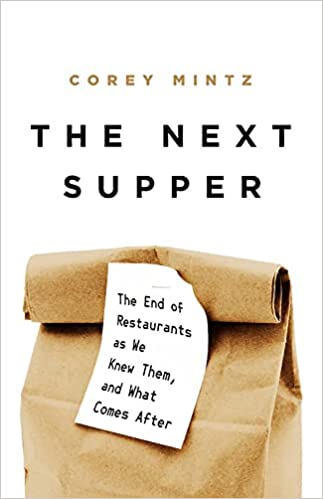You have /5 articles left.
Sign up for a free account or log in.
 The Next Supper: The End of Restaurants as We Knew Them, and What Comes After by Corey Mintz
The Next Supper: The End of Restaurants as We Knew Them, and What Comes After by Corey Mintz
Published in November 2021
The Next Supper is about the impact of the pandemic on the restaurant industry. The book’s author, Corey Mintz, started his career as a chef and later became a restaurant critic and food writer.
As an industry insider, Mintz is highly knowledgeable and distinctly unsentimental about the business of restaurants.
For Mintz, the pandemic is a once-in-a-generation opportunity to reinvent the restaurant. As detailed in The Next Supper, the pre-pandemic restaurant industry was built on a foundation of exploitation. Kitchen staff are often drawn from vulnerable segments of the population, including less educated and undocumented workers.
The chef-driven culture of many high-end restaurants had become synonymous with harassment and abuse. Restaurant workers as a whole suffer from low wages, lack of health insurance and often absent paid sick leave or paid vacation days. Rates of alcohol and drug abuse in food services are among the highest of all industries.
The Next Supper is full of ideas about what the post-pandemic restaurant might look like. These ideas are grounded in the devastating reality of restaurant work during the pandemic: millions of workers initially lost their livelihood, and thousands of restaurants were forced to close their doors. When sit-down dining finally resumed, restaurant workers were on the front lines of dealing with public antimasking anger.
How might a more sustainable and less exploiting restaurant industry emerge post-pandemic?
Mintz sees hope in the shift from sit-down to takeout dining. Eliminating the front of the house may reduce costs and enable restaurants to more equitably share revenues to all employees.
Diners will need to recalibrate their sense of value for the sit-down restaurants that remain. Restaurant meals will need to become more expensive, as low costs and big portions have been subsidized by paying too many kitchen workers too little money. All of us should tip more, and restaurants should distribute those tips to all the people involved in preparing and serving the meal. We should stop thinking of tips as rewards for excellent service and more as part of the normal price of dining out.
What are the higher ed equivalents of low-paid line cooks and dishwashers? Are there areas of our industry that, like restaurants, depend on exploitative labor practices to survive?
The obvious answer to this question is the growing dependence on part-time and contingent faculty across most colleges and universities.
Restaurants, and especially well-known restaurants with famous chefs, can get away with paying much of the kitchen staff below-market wages. Aspiring chefs seek to put work in superstar restaurants on their résumés.
This restaurant industry mismatch between the supply of aspiring chefs (many graduates of culinary schools) and demand (too few Michelin-starred restaurants) that underlies low kitchen wages and poor working conditions reminds me of the labor market for faculty. Too many graduating Ph.D.s and too few tenure-track positions result in overqualified academics settling for contingent faculty roles.
Any parallels between the food service industry and higher education, restaurants and universities, is (of course) a stretch. Still, there is value in thinking about the sort of higher education that we want post-COVID (if that ever comes) as we ruminate on the post-pandemic future of restaurants.
How do you think both colleges and restaurants will be different due to the pandemic?
What are some other books like The Next Supper that offer an informed and critical analysis of restaurants and the restaurant industry?
What are you reading?








